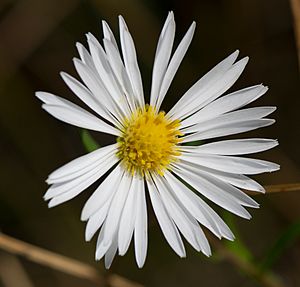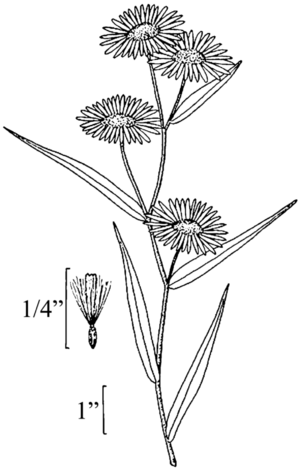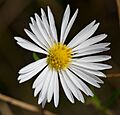Symphyotrichum boreale facts for kids
Quick facts for kids Symphyotrichum boreale |
|
|---|---|
 |
|
| Conservation status | |
| Scientific classification | |
| Genus: |
Symphyotrichum
|
| Species: |
boreale
|
| Synonyms | |
|
|
The Rush Aster (Symphyotrichum boreale) is a beautiful flowering plant. It is also known as the Northern Bog Aster or Slender White Aster. This plant grows naturally in North America. It belongs to the Asteraceae family, which is also called the daisy or sunflower family.
Contents
What the Rush Aster Looks Like
The Rush Aster is a type of plant that comes back every year. This means it is a perennial plant. It can grow to be about 13 to 85 centimeters tall. That's roughly from your knee to your waist!
This plant has thin leaves and stems. It also grows long underground stems called rhizomes. These rhizomes help the plant spread and grow new plants nearby.
The Rush Aster has special flowers called composite flowers. This means each "flower" you see is actually made of many tiny flowers grouped together. The outer petals, called ray florets, are white or light purple. The tiny flowers in the center, called disc florets, start out cream or pale yellow. They then turn a bit purplish as they get older.
How Scientists Name This Plant
For a long time, the Rush Aster was part of a big group of plants called Aster. Its old name was Aster borealis. But scientists learned more about these plants. They found that the Aster group was too broad.
Now, most of the North American asters, including the Rush Aster, are in a different group. This new group is called Symphyotrichum. This helps scientists organize plants better. Sometimes, the Rush Aster can even mix with another plant called Symphyotrichum puniceum. When they do, they create a new kind of plant called Symphyotrichum ×longulum.
Where the Rush Aster Grows
You can find the Rush Aster in many parts of northern North America. It grows from Alaska all the way to Newfoundland in Canada. It also grows south into places like Colorado and West Virginia in the United States.
This plant loves wet places. It often grows in areas with lots of calcium in the soil. You might find it in:
- Fens: These are wetlands fed by groundwater.
- Marshes: These are wetlands with soft, wet land.
- Swamps: These are wetlands with trees.
- Wet meadows: These are grassy areas that are often damp.
How the Rush Aster Spreads
The Rush Aster spreads in two main ways. One way is through its long underground rhizomes. These rhizomes grow new shoots, making more plants in the same area.
The other way it spreads is by its seeds. The seeds are light and can be carried by the wind. This helps the plant move to new places.
The roots of the Rush Aster also have tiny fungi living on them. These fungi help the plant get nutrients from the soil. One type of fungus, called Erysiphe cichoracearum, can cause a plant disease called powdery mildew on the Rush Aster.
Images for kids




